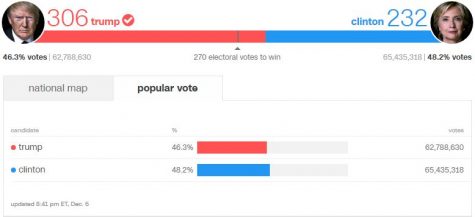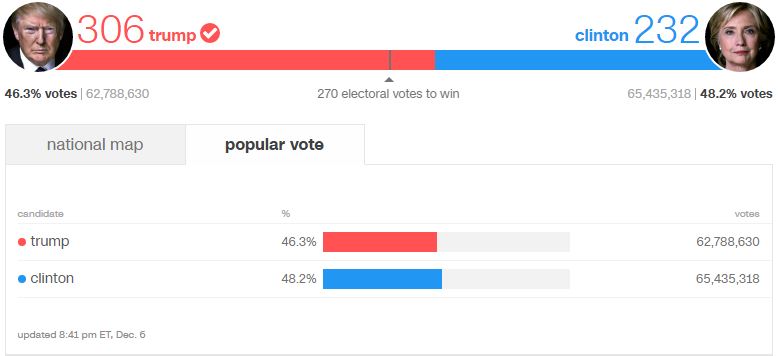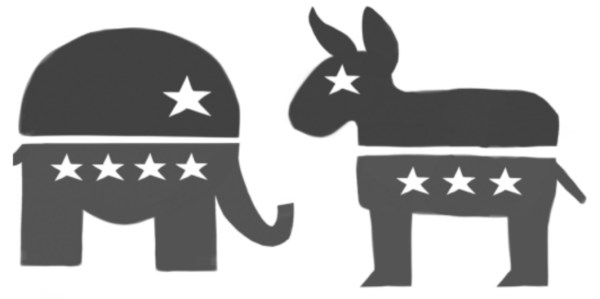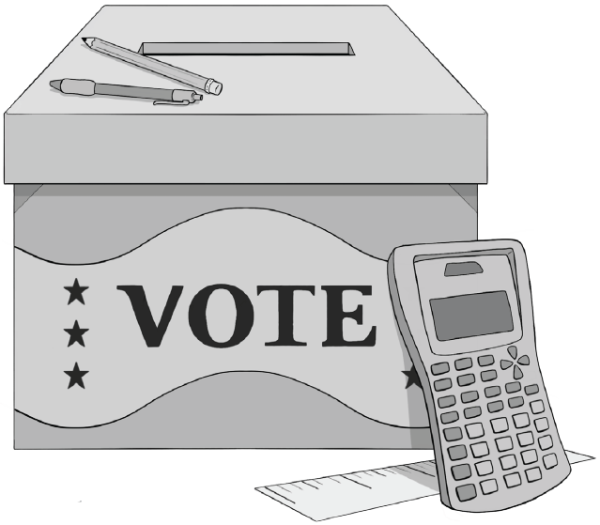The Future of the Trump Presidency
November 28, 2016
On November 8th, the American people voted on who would become the next president of the United States. To many people’s surprise—and in defiance of national polls, political scientists, and politicians’ predictions—Donald Trump obtained 290 electoral votes, 20 more than the 270 vote minimum required to win the presidency, according to CNN. Trump’s Democratic opponent, Hillary Clinton, won only 232 electoral votes, but she won the popular vote by over 1.1 million votes.
This is only the fourth time in the history of the United States that a candidate has lost the popular vote, but managed to win the electoral college, and therefore the election. Following Trump’s undoubtedly divisive campaign, particularly his offensive comments about women, Latinos, African Americans, Muslims, immigrants, and veterans, many Americans have voiced their opposition to his presidency.
Photo courtesy of CNN Money, updated Dec. 6
Despite the electoral college vote on December 19th, and according to the LA Times, the “as many as 75” pending lawsuits he is currently facing, it is almost guaranteed that Mr. Trump will become the next Mr. President. With Republican majorities in both the House and Senate, and multiple Supreme Court vacancies to fill in the near future, the Republican federal government will be able to pass just about anything it wishes. Trump has made numerous promises on the campaign trail about issues ranging from LGTB rights to ISIS. Here is a closer look at some of his main promises, and the actions and policies that are likely to result from them.
Climate Change
Donald Trump famously tweeted in 2012, “the concept of global warming was created by and for the Chinese in order to make U.S. manufacturing non-competitive.” As many readers may remember from the primary and presidential campaigns, he has repeatedly used the word “hoax” to describe climate science.
During the first presidential debate, Hillary Clinton criticized Trump for this statement, to which he replied, “I did not say that. I do not say that. I do not say that.” Regardless of these contradictory claims, Mr. Trump has vowed to repeal President Obama’s Clean Power Plan, which is designed to cut carbon pollution in America.
One of the first jobs of the president elect is to appoint cabinet members and heads of government agencies. To lead the Department of Energy, Trump has appointed energy lobbyist Mike McKenna. Additionally, Trump has chosen Myron Ebell to lead the Environmental Protection Agency transition team.
Ebell, the director of a Washington-based climate anti-advocacy group, stated in an interview, “I believe the vast majority of scientists think [the case behind global warming] is silly.”
For the record, multiple peer-reviewed studies have shown that 97% or more of actively publishing climate scientists agree that climate-warming trends over the past century are “extremely likely due to human activities.” This sends a bleak message about the next four years of environmental policy.
As part of his federal budget plan, Trump has also pledged to cut funding for the EPA. Trump supports expanding fossil fuel production, including highly controversial plans such as the Keystone XL oil pipeline, which President Obama blocked from completing construction.
Trump has also declared that he would “cancel” the 2015 Paris Agreement on climate change, which was signed by over 190 countries. In response, the French President François Hollande stated that the United States “must respect the commitments that were made.” The Secretary-General of the United Nations, Ban Ki-moon, said that he is “sure that [Trump] will understand” the “seriousness and urgency” of addressing the global issue of climate change.
“Draining the Swamp”
One of the Trump team’s primary tasks before taking office is choosing and hiring 4,000 political appointees for positions in the federal government. In the weeks leading up to election day, Trump frequently declared that he would “drain the swamp” that he believes Washington D.C. has become.
An important part of this pledge includes removing corporate lobbyists from government roles. However, Trump selected numerous lobbyists and corporate leaders, as well as several members of his own family to head his transition team. Since he has multiple major business interests that will be directly affected by tax policies over which he has influence, there is concern about likely conflicts of interest. Rudy Giuliani has made assurances, however, that conflict-of-interest laws don’t apply to the president.
Trump recently replaced the head of his transition team, Chris Christie, with Vice President-elect Mike Pence. Pence immediately removed all lobbyists from the transition team, in an effort to follow through on the promise to “drain the swamp.” Many current officials have expressed their unwillingness to continue working under a Trump administration, and without lobbyists, Trump may have more difficulty finding willing and well-qualified experts to fill the vacancies.
Another major part of Trump’s pledge to “drain the swamp” is to cut government jobs and organizations that he deems unnecessary. However, according to NPR, Trump plans to further increase military spending and initiate major infrastructure improvement programs, all while cutting taxes by around six trillion dollars per year.
This means that Trump will have to cut multiple trillion dollars in discretionary spending or increase the national debt that he, and many others, have criticized Democrats for increasing. Trump has also promised not to cut social security or Medicare funding, which supports senior citizens and people with disabilities.
To make up the difference, Trump said in an interview with “Meet the Press” that he “would get rid of some [departments]. For example, the Department of Education. I would certainly get rid of a lot of it.”
Aside from the implications this would have for American citizens—and in particular, students and teachers—Trump’s plan to “reduce the federal workforce through attrition,” as described in a campaign statement, could threaten the jobs of many of the 2.75 million people who are employed in the federal workforce according to the Bureau of Labor Statistics.
Unity
The 2016 presidential race was undeniably one of the most divisive, if not the most divisive, in the history of the United States. On the Democratic side, Hillary Clinton was repeatedly accused of crimes related to the use of a private email server during her time as Secretary of State, although after two thorough investigations, the FBI judged that “no reasonable prosecutor” would bring a case for criminal charges against Clinton to court. She most notably took strong criticism for a distasteful comment about Trump supporters.
Clinton said, “You know, to just be grossly generalistic, you could put half of Trump’s supporters into what I call the basket of deplorables. Right? The racist, sexist, homophobic, xenophobic, Islamophobic — you name it. And unfortunately there are people like that. And he has lifted them up.”
Trump’s campaign, however, has evidently been more widely dominated by insults and hateful language. As mentioned before, the groups targeted by Trump’s insults have included women, Latinos, African Americans, Muslims, immigrants, and veterans. In fact, the New York Times has compiled “The 282 People, Places and Things Donald Trump Has Insulted on Twitter: A Complete List.” The topics range from fellow Republicans, to media outlets, and to even the department store, Macy’s.
In October, a 2005 video surfaced of Trump talking in very vulgar terms about kissing, groping, and trying to have sex with women. These actions amount to no less than sexual assault. Such a video would have almost certainly cost any other candidate the race.
Despite these incidents, Donald Trump won the election and is set to become the next President of the United States. In his victory speech, Trump called on all Americans to put aside their differences and come together in unity.
“Now it’s time for America to bind the wounds of division; have to get together. To all Republicans and Democrats and independents across this nation, I say it is time for us to come together as one united people.”
Trump pledged “to every citizen of our land that [he] will be president for all Americans.” This may mean that Trump will work to protect the rights of minorities, including those he has insulted in the past. Trump is not a traditional conservative, and has been described as one of the “freest” presidents ever from partisan policies. With this freedom, and the proud label of a political outsider, it is possible that Trump may diverge from Republicans on many social issues in an effort to respect the values of all Americans.
In his 100-day action plan, he outlined three areas of focus: “clean up the corruption and special interest collusion in Washington,” “protect American workers,” and “restore security and the constitutional rule of law.” These topics steer largely clear of social issues, the area of Trump’s campaign—and disposition—causing the most concern among many people who identify as minorities.
By working together with both Democrats and Republicans, and respecting the concerns of all Americans, perhaps Donald Trump will succeed in doing what he has always promised to do: make America great again. At least he might not make it worse.
































